When it comes to testing and developing upper body strength and size, most lifters turn to the bench press. The bench press is one of the most popular gym exercises around and is also part of the sport of powerlifting. If you get a couple of gym-goers together in the same room, invariably, they’ll talk about how much weight they can bench.
However, there is another exercise that could be even better for building strength and size in your upper body – the overhead press.
In the bench press, your body is supported by the bench so that your chest, shoulders, and arms do all the work. In contrast, the overhead press, especially when done while standing, involves a whole lot more muscle mass. It would be fair to call the standing overhead press a whole-body exercise.
The overhead press is also more functional than the bench press. That is to say, it replicates every day or sporting activities. For example, lifting a heavy object above your head to place on a shelf. In contrast, the bench press is considered much less functional. After all, how often do you lie on your back to lift something heavy?
That doesn’t mean the bench press is a “bad” exercise. It’s actually an excellent workout for your chest. However, adding overhead presses to your workouts will improve how your upper body looks and performs.
Overhead press anatomy
The main muscles involved in overhead presses are:
- The deltoids – the three main shoulder muscles consisting of the anterior or front deltoid, medial or side deltoid, and posterior or rear deltoid. These muscles flex, abduct and extend your shoulder joint.
- Trapezius – the kite-shaped muscle of your upper back, responsible for elevation, depression, and retraction of the shoulder girdle.
- Triceps brachii – the three-headed muscle on the back of your upper arm. This is your main elbow extender.
- Core – the collective name for the muscles of the midsection, including rectus abdominus, obliques, and transverse abdominus. These muscles work together to stabilize your spine.
- Erector spinae – the muscles of the lower back, responsible for extending your spine and also keeping it stable.
- Glutes, quadriceps, and hamstrings – the muscles of the hips, front of the thigh, and back of the thigh respectively. These muscles work isometrically or statically in the overhead press to provide you with a stable platform from which to press.

How to do overhead presses
To perform the overhead press…
- Place a barbell in a squat rack, so it’s level with your upper chest.
- Hold the bar with an overhand, slightly wider than shoulder-width grip.
- Stand close to the bar, so it rests across the front of your shoulders. Your elbows should be directly below your hands.
- Unrack the bar and take a small step back.
- Brace your core tightly and lift your chest.
- Press the bar straight overhead to full lockout.
- Lower the bar back to your shoulders and repeat as necessary.
How to increase your overhead pressing strength
While you could keep plugging away at the overhead press in the hope that you’ll get stronger and bigger in the process, studies suggest that the best way to make progress is through exercise variety (1). In other words, you need to mix things up to maximize your progress.
Here are four exercises that will help increase your overhead pressing strength. Use them to add variety to your workouts. You should too notice too that, as you get stronger, your upper body gets bigger too.
You should also find that as your overhead pressing strength increases, so too does your bench press strength. There is a strong link between overhead pressing performance and bench press performance.
1. Z Press
The Z press is a super-strict overhead press that forces you to use your core more than you would in regular overhead presses. It also stops you using your legs, which means it really emphasizes your delts, traps, and triceps.
To perform the Z press:
- Place a barbell in a squat rack set to about hip-height.
- Sit on the floor with your legs apart.
- Grab the barbell with an overhand, shoulder-width grip. Brace your abs and lift your chest.
- Unrack the bar and press it overhead. Do not lean backward or allow your lower back to round.
- Lower the bar back to your shoulders and repeat.
This exercise can also be performed with dumbbells or kettlebells.
Watch How to Z Press:
2. Pin Presses
Pin presses start from a dead stop. This makes them much harder than regular overhead presses. From a dead stop, you have to work extra hard to get the bar moving; you really have to explode into each and every rep. This exercise will have a significant impact on your overhead pressing performance, as well as shoulder and triceps hypertrophy.
How to perform pin presses:
- Set the safety pins in a power rack to shoulder-height and rest your barbell on the pins.
- Grab the bar with an overhand, shoulder-width grip. Stand close to the bar so that it is touching your shoulders. Brace your core and set your lower body.
- Press the bar off the pins and up to full arm extension.
- Lower the bar back to the pins, allowing the weight to settle, and then press again. Each rep should begin with the bar completely stationary and resting on the safety pins. Do not bounce it off the pins.
Watch How to Pin Press:
3. Push Presses
A proper overhead press should be done strictly, i.e., without any assistance from the lower body. Your legs are involved in the overhead press, but only for stability. Keeping your legs out of the exercise is the best way to test your overhead pressing strength.
However, in push presses, you purposely use your legs so you can lift more weight. This exposes your muscles to more work and tension than usual, especially as you lower the bar back to your shoulders. This means you can train with heavier weights than normal, which will boost your regular overhead press performance.
How to perform push presses:
- Place a barbell in a squat rack, so it’s level with your upper chest.
- Hold the bar with an overhand, slightly wider than shoulder-width grip.
- Stand close to the bar, so it rests across the front of your shoulders. Your elbows should be directly below your hands.
- Unrack the bar and take a small step back.
- Brace your core tightly and lift your chest.
- Bend your legs and descend into a quarter-depth squat.
- Explosively extend your legs and use this momentum to help you push the weight up and overhead.
- Lower the weight under control back to your shoulders and repeat. Make sure you lower the bar slowly to maximize the work done by your shoulders and triceps.
Watch How to Push Press:
4. Overhead barbell press with bands or chains
Using bands or chains increases the load at the end of each rep. This forces you to use your triceps more and also teaches you to start each rep much more explosively and aggressively. The harder and faster you begin each rep, the more weight you’ll be able to lift.
Powerlifters use bands and chains to increase squat, bench press, and deadlift performance, but there is no reason you can’t use them to improve your overhead press strength too. This is a tough training method that is best left to experienced intermediate and advanced lifters.
How to perform overhead presses with bands:
- Attach a band to each end of your barbell and then fix them to the floor with heavy dumbbells or a pin on your power rack. The band should be fairly slack at the start of each rep.
- Do your reps as usual. However, the last third of each rep should feel much harder than normal.
- Load the bar with less weight to reflect this.
How to perform overhead presses with chains:
- Place a barbell in a squat rack, so it’s level with your upper chest.
- Attach a chain to each end of the barbell. Make sure 2-3 feet of chain is on the floor.
- Do your reps as normal. As more of the chain leaves the floor, the weight will increase, and the rep will feel harder.
- Lower the bar and repeat.
You can also use bands or chains for Z presses and pin presses.
Workouts for increased overhead pressing strength
Here are two workouts designed to increase your overhead pressing strength and build upper body muscle mass. Do these workouts on non-constitutive days, i.e., Monday and Thursday.
Follow this program for 4-6 weeks and then retest your overhead strength.
| Workout one | ||||
| Exercise | Sets | Reps | Recovery | |
| 1 | Z press | 4 | 6 | 2 minutes |
| 2 | Push-press | 3 | 8 | 2 minutes |
| 3 | Alternating DB overhead press | 3 | 10 | 90 seconds |
| 4 | Cable side raises | 2 | 12 | 60 seconds |
| 5 | Cable front raises | 2 | 12 | 60 seconds |
Here is the second workout:
| Workout two | ||||
| Exercise | Sets | Reps | Recovery | |
| 1 | Pin press | 4 | 6 | 2 minutes |
| 2 | Overhead press with bands or chains | 3 | 8 | 2 minutes |
| 3 | Single-arm dumbbell overhead press | 3 | 10 | 90 seconds |
| 4 | Dumbbell side raises | 2 | 12 | 60 seconds |
| 5 | Plate front raises | 2 | 12 | 60 seconds |
Wrap up
A big overhead press is every bit as impressive as a heavy bench press. In many ways, the overhead press is better than the bench press because it involves more muscles. However, you don’t need to choose between these two popular lifts. Instead, train both of them equally.
Not only will your general pressing performance increase, but you’ll also add slabs of muscle to your upper body and arms. This is a win-win situation!
References:
Journal of Strength and Conditioning Research: November 2014 – Volume 28 – Issue 11 – p 3085–3092, doi: 10.1519/JSC.0000000000000539 https://journals.lww.com/nsca-jscr/fulltext/2014/11000/Changes_in_Exercises_Are_More_Effective_Than_in.9.aspx

